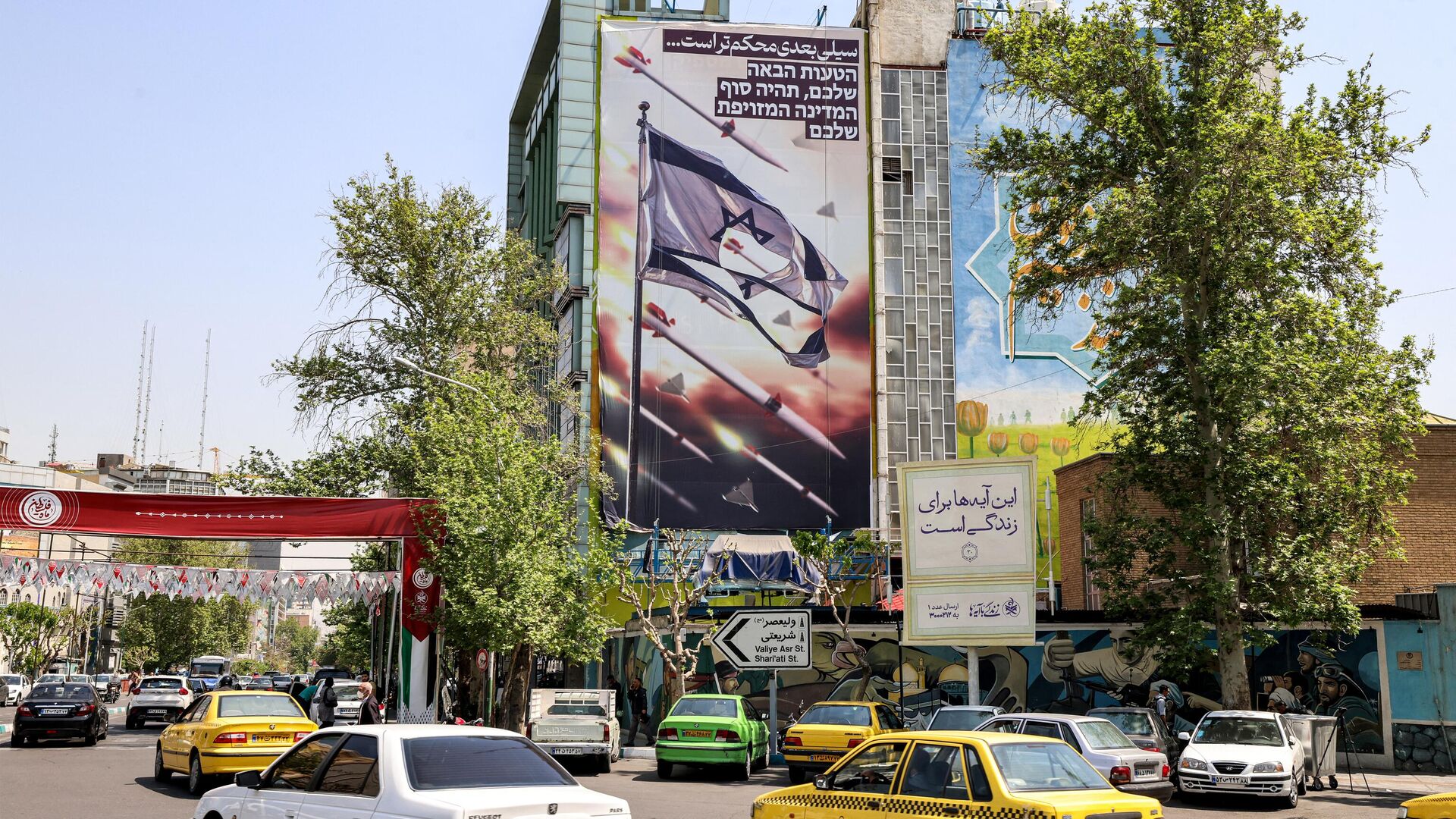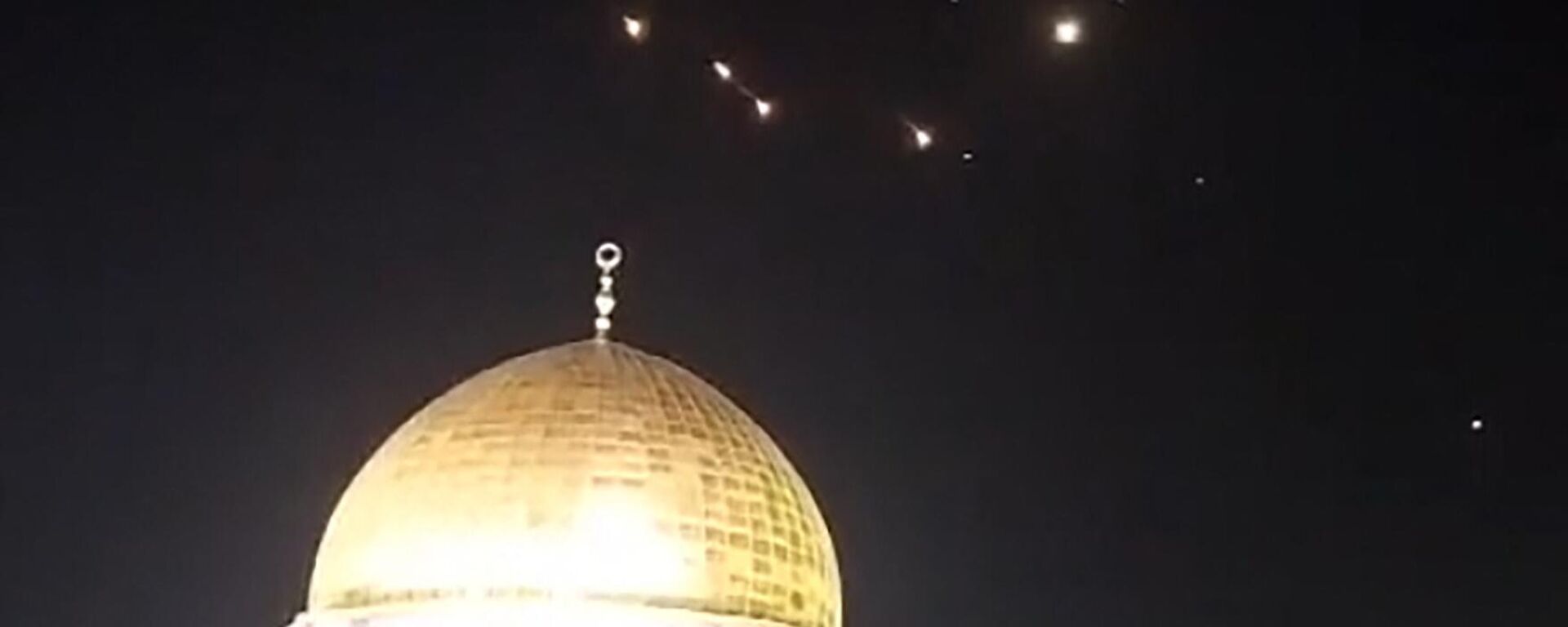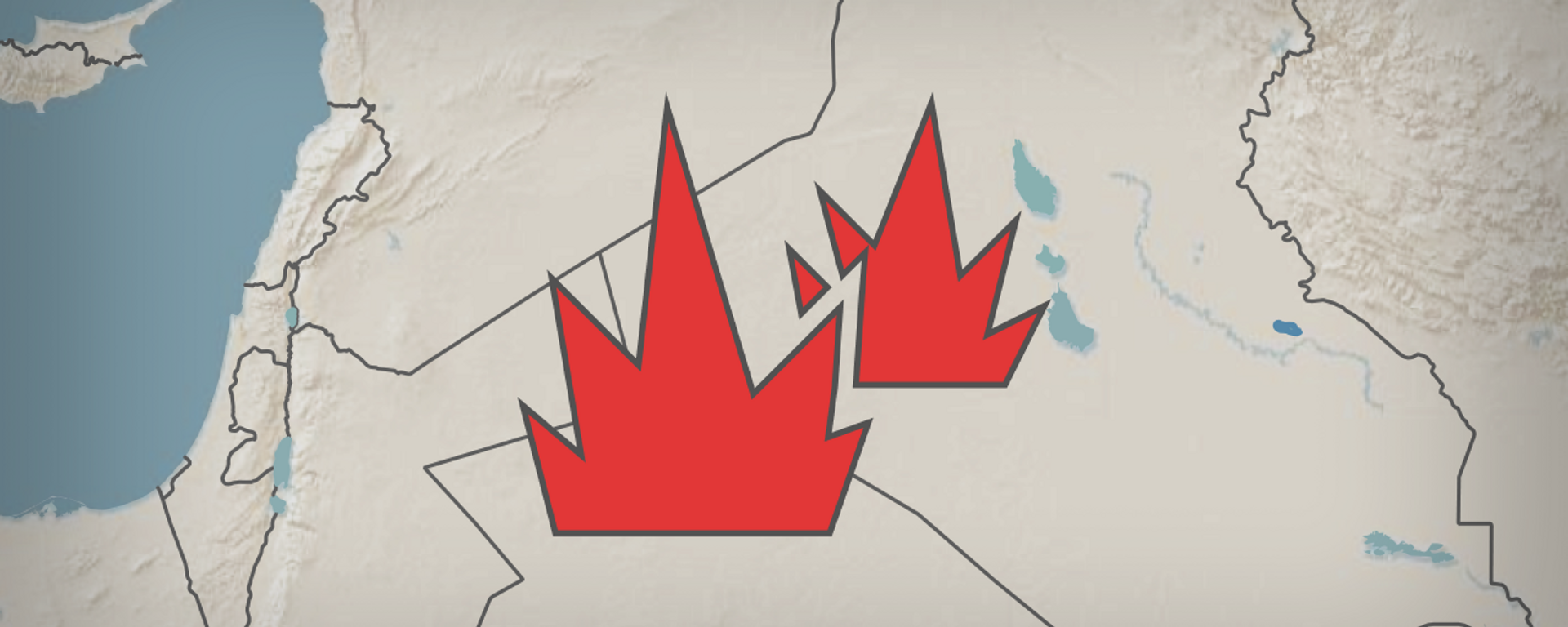https://sputnikglobe.com/20240414/scoop-iran-may-have-used-new-hypersonic-missiles-to-pierce-israeli-air-defenses-1117930117.html
Scoop: Iran May Have Used New Hypersonic Missiles to Pierce Israeli Air Defenses
Scoop: Iran May Have Used New Hypersonic Missiles to Pierce Israeli Air Defenses
Sputnik International
IRGC chief Hossein Salami said Sunday that the ‘Operation True Promise’ missile and drone barrage against Israel was “more successful than expected,” with projectiles managing to piece Israel’s advanced, multilayered air defense system. The IDF said it intercepted “99 percent” of incoming Iranian projectiles.
2024-04-14T16:39+0000
2024-04-14T16:39+0000
2024-04-14T16:39+0000
military
hossein salami
mohammad hossein bagheri
israel
iran
syria
islamic revolutionary guard corps (irgc)
israel defense forces (idf)
f-35i
middle east
https://cdn1.img.sputnikglobe.com/img/07e8/04/0e/1117929934_0:160:3072:1888_1920x0_80_0_0_87767967a190591609233bb68288274c.jpg
Iran may have fired its brand new Fattah 2 hypersonic missile at targets inside Israel during Saturday’s overnight attack on Israeli military facilities, Dr. Ali Hamie, a Lebanese academic and national security expert, told Sputnik Arabic on Sunday.The Lebanese expert suggested that Israel’s “foolish” decision to target the Iranian Embassy compound in Damascus on April 1 – which triggered the Iranian retaliation Saturday night, could culminate in combined attacks against the Jewish State from Iran, Lebanon, Syria, Iraq and Yemen, which Tel Aviv would have difficulty withstanding.“If the United States intervenes, the war may not be limited to the region, but will expand beyond it,” Hamie warned, pointing to the presence of not only Iranian but Russian forces in Syria on a counterterrorism mission.Dr. Hamie did not elaborate on the source or nature of his information regarding the Fattah-2’s possible use in Saturday night’s attacks, with Iranian officials and military commanders staying mum when it comes to the weapons used. Footage posted to social media showed Iranian Shahed-series drones flying low to the ground to evade radar, but the missiles involved in the strikes have yet to be confirmed, with the Islamic Republic known to possess a broad array of domestically-developed long-range missiles capable of hitting Israel from Iranian soil.Commenting on this information, Tehran University Professor Mohammad Marandi said there was no information to confirm that Iran used its fledgling hypersonic capabilities in Saturday night's strikes.Iran’s Primary TargetWhether or not hypersonics were used, what is known for certain about Saturday’s overnight strikes is that despite the Israeli military’s assurance that “99 percent” of the 300+ Iranian drones and missiles launched were intercepted, at least some are known to have made it through, with the IRGC saying “designated targets,” including the strategic Nevatim Air Base situated in the Negev Desert, had been hit. The IDF confirmed “light damage” to the facility, which is known to host F-35I jets. However, the Iran in Arabic news agency has reported that Nevatim is also a permanent Mossad base, and that at least 44 intelligence officers were killed in Iranian attack.Israeli media have not commented on this claim, but the Times of Israel did confirm that Nevatim was one of the primary targets of Saturday’s attacks. Social media footage showed Iranian missiles touching down in the base's vicinity after bypassing Israel’s air and missile defenses.Israeli media further indicated that Netanyahu’s official plane, the ‘Wing of Zion’, had taken off from Nevatim several hours before the attack to prevent being targeted.The IDF assured that the base was in tip top shape in an X post Sunday morning, posting a video of an F-35I coming in for landing at Nevatim as confirmation that the facility was operational, but not providing footage of the base’s structures.Iranian Armed Forces Chief of Staff Mohammad Bagheri told media Sunday that Iran’s attack targeted to sites: “the Nevatim Airbase hosting the F-35 planes that were used for targeting our consulate in Damascus,” and an Israeli intelligence-gathering facility in the Jabal al-Shaykh heights in Israeli-occupied Lebanese territory.Iranian media reported that “at least seven” missiles had also struck Israel’s Ramon Airbase, also situated in the Negev Desert, and hosting Israeli F-16I jets. Israel has not confirmed this information.In an after-action report early Sunday, IRGC chief Hossein Salami confirmed that Iran’s “limited” strikes had targeted Israeli military facilities in the Golan Heights and the Negev Desert. “So far, we have not collected all the data relating to the strikes, but detailed, documented reports from the scene show that the operation was more successful than we expected,” the commander said.Nevertheless, Salami said, “dozens of ballistic and cruise missiles managed to break into deep layers of Israel’s seemingly safe air defense system, impact the aerial coalition between the US, France and Israel and reach the designated targets.”
https://sputnikglobe.com/20240414/live-updates-iran-and-israel-to-speak-at-urgent-unsc-meeting-on-sunday---source-1117929563.html
https://sputnikglobe.com/20240414/infographics-irans-operation-true-promise-launched-on-israel-1117926406.html
israel
iran
syria
Sputnik International
feedback@sputniknews.com
+74956456601
MIA „Rossiya Segodnya“
2024
News
en_EN
Sputnik International
feedback@sputniknews.com
+74956456601
MIA „Rossiya Segodnya“
Sputnik International
feedback@sputniknews.com
+74956456601
MIA „Rossiya Segodnya“
did iran use hypersonic missiles against israel, does iran have hypersonic missiles, what kinds of hypersonic missiles does iran have
did iran use hypersonic missiles against israel, does iran have hypersonic missiles, what kinds of hypersonic missiles does iran have
Scoop: Iran May Have Used New Hypersonic Missiles to Pierce Israeli Air Defenses
IRGC chief Hossein Salami said Sunday that the ‘Operation True Promise’ missile and drone barrage against Israel was “more successful than expected,” with projectiles managing to pierce Israel’s powerful multilayered air defense system. The IDF says it intercepted “99 percent” of incoming Iranian projectiles.
Iran may have fired its brand new
Fattah 2 hypersonic missile at targets inside Israel during Saturday’s overnight attack on Israeli military facilities,
Dr. Ali Hamie, a Lebanese academic and national security expert,
told Sputnik Arabic on Sunday.
“Iran launched hundreds of Shahid series drones and Fattah 2 hypersonic cruise missiles into Israel, which the Israeli Iron Dome air defense system was incapable of intercepting,” Hamie said.
The Lebanese expert suggested that Israel’s “foolish” decision to target the Iranian Embassy compound in Damascus on April 1 – which triggered the Iranian retaliation Saturday night, could culminate in combined attacks against the Jewish State from Iran, Lebanon, Syria, Iraq and Yemen, which Tel Aviv would have difficulty withstanding.
“If the United States intervenes, the war may not be limited to the region, but will expand beyond it,” Hamie warned, pointing to the presence of not only Iranian but Russian forces in Syria on a counterterrorism mission.
Dr. Hamie did not elaborate on the source or nature of his information regarding the Fattah-2’s possible use in Saturday night’s attacks, with Iranian officials and military commanders staying mum when it comes to the weapons used. Footage posted to social media showed Iranian
Shahed-series drones flying low to the ground to evade radar, but the missiles involved in the strikes have yet to be confirmed, with the Islamic Republic known to possess a
broad array of domestically-developed long-range missiles capable of hitting Israel from Iranian soil.
The Fattah-2 (lit. ‘Conqueror-2’ or ‘Victory Giver-2’) is virtually a brand new, liquid-fueled Iranian hypersonic missile which was unveiled in November 2023, and has a declared range of 1,500 km, a 450 kg warhead and the ability to accelerate to hypersonic speeds and maneuver in flight. The Fattah-2 is a successor to the Fattah-1, a two-stage, solid fuel missile with a 1,400 km range and a 350-450 kg payload. The Fattah-1 was unveiled in the summer of 2023, inaugurating Iran into the small handful of nations with hypersonic capabilities.
Commenting on this information, Tehran University Professor Mohammad Marandi said there was no information to confirm that Iran used its fledgling hypersonic capabilities in Saturday night's strikes.
"Iran has not fired its hypersonic missiles. In fact, most of the drones and missiles that were fired were older drones and missiles. They were very inexpensive and were used as decoys. So Iran spent a couple of million dollars to force the Israelis to spend $1.3 billion in anti-missile missiles, which was itself a big achievement by the Iranians. And then a number of other missiles that the Iranians fired...cut through and struck their targets," the academic and geopolitical affairs commentator told Sputnik.
Whether or not hypersonics were used, what is known for certain about Saturday’s overnight strikes is that despite the Israeli military’s assurance that
“99 percent” of the 300+ Iranian drones and missiles launched were intercepted, at least some are known to have made it through, with the IRGC saying “designated targets,” including the strategic
Nevatim Air Base situated in the Negev Desert, had been hit. The IDF confirmed “light damage” to the facility, which is known to host
F-35I jets. However, the Iran in Arabic news agency has
reported that Nevatim is also a permanent Mossad base, and that at least 44 intelligence officers were killed in Iranian attack.
Israeli media have not commented on this claim, but the Times of Israel
did confirm that Nevatim was one of the primary targets of Saturday’s attacks. Social media
footage showed Iranian missiles touching down in the base's vicinity after bypassing Israel’s air and missile defenses.
Israeli media further indicated that Netanyahu’s official plane, the ‘Wing of Zion’,
had taken off from Nevatim several hours before the attack to prevent being targeted.
The IDF assured that the base was in tip top shape in an X post Sunday morning, posting a
video of an F-35I coming in for landing at Nevatim as confirmation that the facility was operational, but not providing footage of the base’s structures.
Iranian Armed Forces Chief of Staff Mohammad Bagheri told media Sunday that Iran’s attack targeted to sites: “the Nevatim Airbase hosting the F-35 planes that were used for targeting our consulate in Damascus,” and an Israeli intelligence-gathering facility in the Jabal al-Shaykh heights in Israeli-occupied Lebanese territory.
“Both of these centers were destroyed to a considerable extent and became inactive. In this operation, a significant number of UAVs, ballistic and cruise missiles were used, along with well thought-out tactics which neither the Iron Dome nor [Israel’s] missile defense shield could take significant action [against],” Bagheri
said.
Iranian media reported that
“at least seven” missiles had also struck Israel’s Ramon Airbase, also situated in the Negev Desert, and hosting Israeli F-16I jets. Israel has not confirmed this information.
In an after-action report early Sunday, IRGC chief Hossein Salami confirmed that Iran’s “limited” strikes had targeted Israeli military facilities in the Golan Heights and the Negev Desert. “So far, we have not collected all the data relating to the strikes, but detailed, documented reports from the scene show that the operation was more successful than we expected,” the commander said.
“The deep and multilayered air defenses, with assistance from the US, [stretched] from Iraqi airspace to Jordan and even parts of Syria and Palestine,” Salami said. “Israel was using its F-15, F-16, and state-of-the-art F-35 fighter jets, Gulfstream jets, as well as aerial refueling aircraft…to defend Israel’s positions,” making it “extremely difficult” to penetrate defenses.
Nevertheless, Salami said, “dozens of ballistic and cruise missiles managed to break into deep layers of Israel’s seemingly safe air defense system, impact the aerial coalition between the US, France and Israel and reach the designated targets.”
Sorting out Iran and Israel’s contradictory accounts of the night’s drone and missile barrage will take time, and require the publication of new footage, satellite photos, or the remains of Iranian missiles to corroborate statements made by either side. The actions taken by Israel in the days to come, which may or may not include direct attacks inside Iran, will offer additional clues about what happened Saturday night, with Armed Forces Chief Bagheri warning that such an attack would bring about an Iranian counterstrike "tens of times" more powerful than that which took place Saturday.




